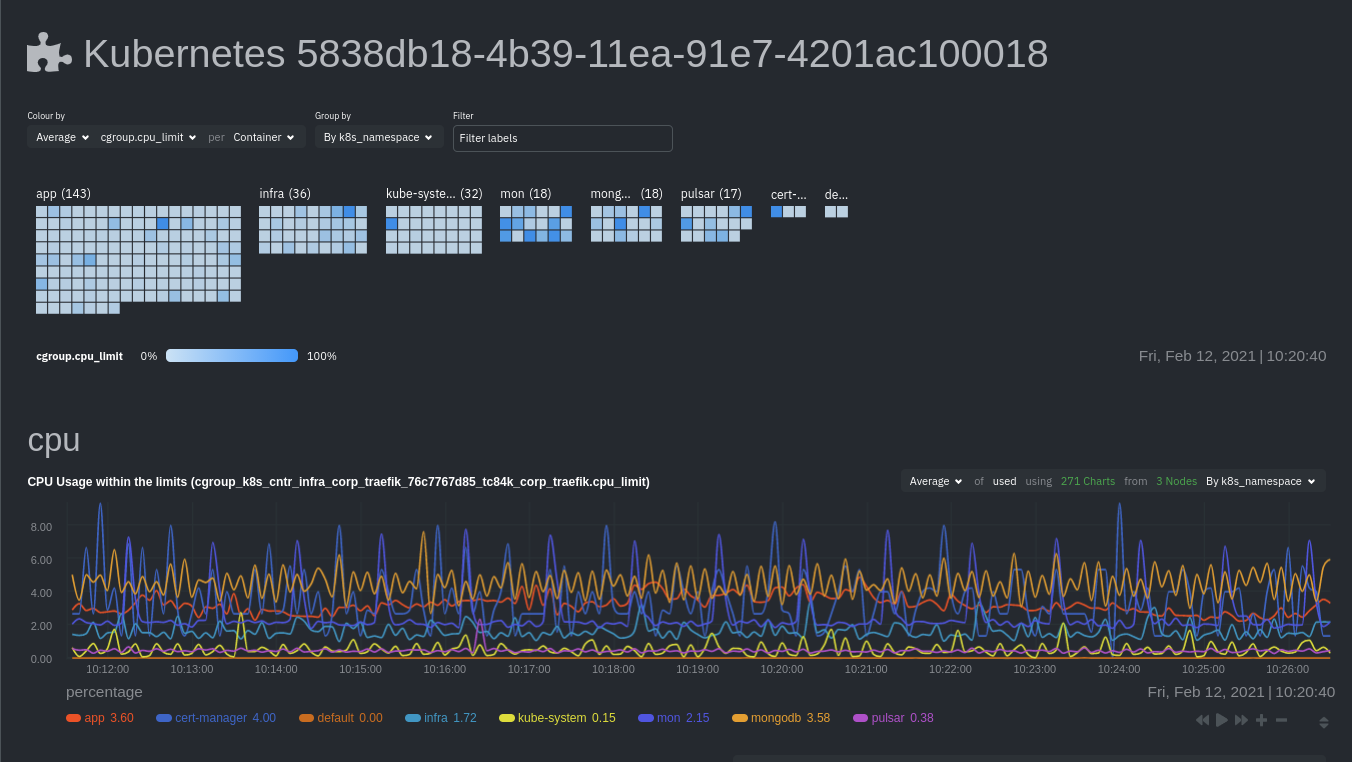Install Netdata on Kubernetes
This document details how to install Netdata on an existing Kubernetes (k8s) cluster, and connect it to Netdata Cloud.
Read our Kubernetes visualizations documentation, to see what you will get.
The Netdata Helm chart installs one parent pod for storing metrics and managing alert notifications, plus an additional child pod for every node in the cluster, responsible for collecting metrics from the node, Kubernetes control planes, pods/containers, and supported application-specific metrics.
Prerequisites
To deploy Kubernetes monitoring with Netdata, you'll need:
- A working cluster running Kubernetes v1.9 or newer.
- The kubectl command line tool, within one minor version difference of your cluster, on an administrative system.
- The Helm package manager v3.0.0 or newer on the same administrative system.
- A Netdata Cloud account with a Space to connect the cluster to.
Deploy Netdata on your Kubernetes Cluster
First, you need to add the Netdata helm repository, and then install Netdata.
The installation process securely connects your Kubernetes cluster to stream metrics data to Netdata Cloud, enabling Kubernetes-specific visualizations like the health map and time-series composite charts.
- New Installations
- Existing Installations
Install Netdata via the helm install command
Steps
-
Add the Netdata Helm chart repository by running:
helm repo add netdata https://netdata.github.io/helmchart/ -
To install Netdata using the
helm installcommand, run:helm install netdata netdata/netdatanoteIf you plan to connect the node to Netdata Cloud, you can find the command with the right parameters by clicking the "Add Nodes" button in your Space's Nodes tab.
For more installation options, please read our Netdata Helm chart for Kubernetes reference.
Expected Result
Run kubectl get services and kubectl get pods to confirm that your cluster now runs a netdata service, one parent pod, and multiple child pods.
Connect an existing Netdata installation to Netdata Cloud
On an existing installation, in order to connect it to Netdata Cloud you will need to override the configuration values by running the helm upgrade command and provide a file with the values to override.
Steps
-
You can start with creating a file called
override.ymltouch override.yml -
Paste the following into your
override.ymlfile.parent:
claiming:
enabled: true
token: YOUR_CLAIM_TOKEN
rooms: YOUR_ROOM_ID_A,YOUR_ROOM_ID_B
child:
claiming:
enabled: true
token: YOUR_CLAIM_TOKEN
rooms: YOUR_ROOM_ID_A,YOUR_ROOM_ID_B
configs:
netdata:
data: |
[db]
db = ram
retention = 3600
[health]
enabled = nonoteMake sure to replace
YOUR_CLAIM_TOKENwith the claim token of your space, andYOUR_ROOM_IDwith the ID of the Room you are willing to connect to.These settings connect your
parent/childnodes to Netdata Cloud and store more metrics in the nodes' time-series databases.infoThese override settings, along with the Helm chart's defaults, will retain an hour's worth of metrics (
retention = 3600, or3600 seconds) on each child node. Based on your metrics retention needs, and the resources available on your cluster, you may want to increase thehistorysetting. -
To apply these new settings, run:
helm upgrade -f override.yml netdata netdata/netdata
Expected Result
The cluster terminates the old pods and creates new ones with the proper persistence and connection configuration. You'll see your nodes, containers, and pods appear in Netdata Cloud in a few seconds.

Configure your Netdata monitoring deployment
Read up on the various configuration options in the Helm chart documentation if you need to tweak your Kubernetes monitoring.
Your first option is to create an override.yml file, if you haven't created one already upon deploying, then apply the new configuration to your cluster with helm upgrade.
helm upgrade -f override.yml netdata netdata/netdata
If you want to change only a single setting, use the --set argument with helm upgrade. For example, to change the
size of the persistent metrics volume on the parent node:
helm upgrade --set parent.database.volumesize=4Gi netdata netdata/netdata
Configure service discovery
Netdata's service discovery, installed as part of the Helm chart installation, finds what services are running in a cluster's containers and automatically collects service-level metrics from them.
Service discovery supports popular applications and Prometheus endpoints.
If your cluster runs services on non-default ports or uses non-default names, you may need to configure service discovery to start collecting metrics from your services. You have to edit the default ConfigMap that is shipped with the Helmchart and deploy that to your cluster.
First, copy the default file to your administrative system.
curl https://raw.githubusercontent.com/netdata/helmchart/master/charts/netdata/sdconfig/child.yml -o child.yml
Edit the new child.yml file according to your needs. See the Helm chart configuration and the file itself for details.
You can then run helm upgrade with the --set-file argument to use your configured child.yml file instead of the
default, changing the path if you copied it elsewhere.
helm upgrade --set-file sd.child.configmap.from.value=./child.yml netdata netdata/netdata
Now that you pushed an edited ConfigMap to your cluster, service discovery should find and set up metrics collection from your non-default service.
Update/reinstall the Netdata Helm chart
If you update the Helm chart's configuration, run helm upgrade to redeploy your Netdata service, replacing netdata
with the name of the release, if you changed it upon installation:
helm upgrade netdata netdata/netdata
To update Netdata's Helm chart to the latest version, run helm repo update, then deploy upgrade it`:
helm repo update
helm upgrade netdata netdata/netdata
Do you have any feedback for this page? If so, you can open a new issue on our netdata/learn repository.